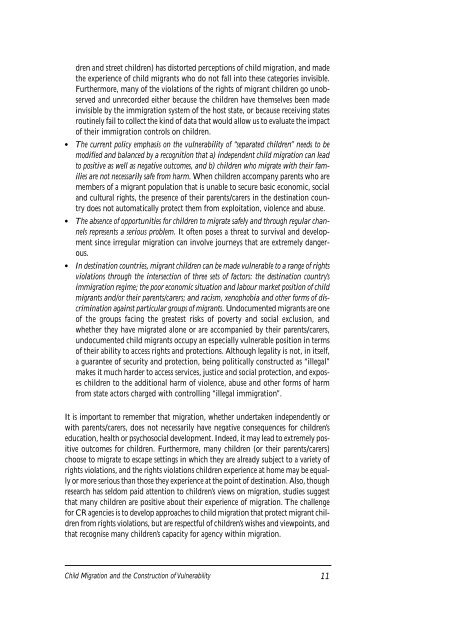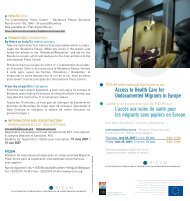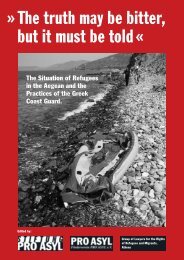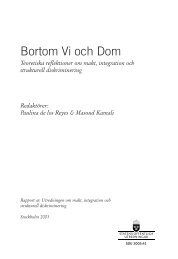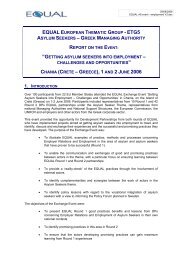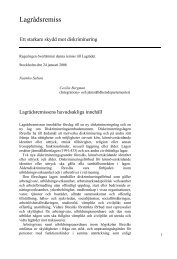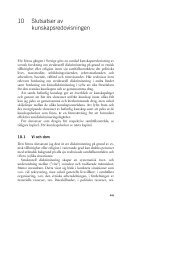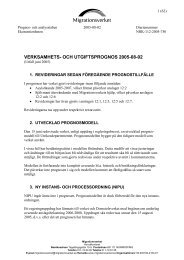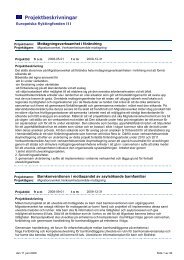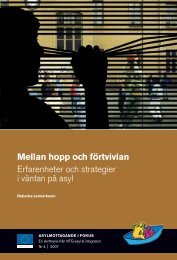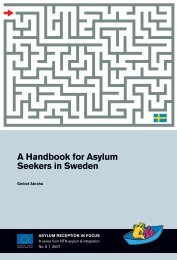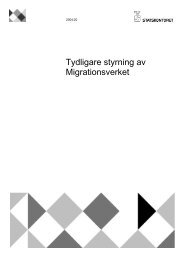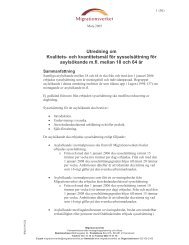and the Construction of Vulnerability - Child Trafficking
and the Construction of Vulnerability - Child Trafficking
and the Construction of Vulnerability - Child Trafficking
Create successful ePaper yourself
Turn your PDF publications into a flip-book with our unique Google optimized e-Paper software.
●<br />
●<br />
●<br />
dren <strong>and</strong> street children) has distorted perceptions <strong>of</strong> child migration, <strong>and</strong> made<br />
<strong>the</strong> experience <strong>of</strong> child migrants who do not fall into <strong>the</strong>se categories invisible.<br />
Fur<strong>the</strong>rmore, many <strong>of</strong> <strong>the</strong> violations <strong>of</strong> <strong>the</strong> rights <strong>of</strong> migrant children go unobserved<br />
<strong>and</strong> unrecorded ei<strong>the</strong>r because <strong>the</strong> children have <strong>the</strong>mselves been made<br />
invisible by <strong>the</strong> immigration system <strong>of</strong> <strong>the</strong> host state, or because receiving states<br />
routinely fail to collect <strong>the</strong> kind <strong>of</strong> data that would allow us to evaluate <strong>the</strong> impact<br />
<strong>of</strong> <strong>the</strong>ir immigration controls on children.<br />
The current policy emphasis on <strong>the</strong> vulnerability <strong>of</strong> “separated children” needs to be<br />
modified <strong>and</strong> balanced by a recognition that a) independent child migration can lead<br />
to positive as well as negative outcomes, <strong>and</strong> b) children who migrate with <strong>the</strong>ir families<br />
are not necessarily safe from harm. When children accompany parents who are<br />
members <strong>of</strong> a migrant population that is unable to secure basic economic, social<br />
<strong>and</strong> cultural rights, <strong>the</strong> presence <strong>of</strong> <strong>the</strong>ir parents/carers in <strong>the</strong> destination country<br />
does not automatically protect <strong>the</strong>m from exploitation, violence <strong>and</strong> abuse.<br />
The absence <strong>of</strong> opportunities for children to migrate safely <strong>and</strong> through regular channels<br />
represents a serious problem. It <strong>of</strong>ten poses a threat to survival <strong>and</strong> development<br />
since irregular migration can involve journeys that are extremely dangerous.<br />
In destination countries, migrant children can be made vulnerable to a range <strong>of</strong> rights<br />
violations through <strong>the</strong> intersection <strong>of</strong> three sets <strong>of</strong> factors: <strong>the</strong> destination country’s<br />
immigration regime; <strong>the</strong> poor economic situation <strong>and</strong> labour market position <strong>of</strong> child<br />
migrants <strong>and</strong>/or <strong>the</strong>ir parents/carers; <strong>and</strong> racism, xenophobia <strong>and</strong> o<strong>the</strong>r forms <strong>of</strong> discrimination<br />
against particular groups <strong>of</strong> migrants. Undocumented migrants are one<br />
<strong>of</strong> <strong>the</strong> groups facing <strong>the</strong> greatest risks <strong>of</strong> poverty <strong>and</strong> social exclusion, <strong>and</strong><br />
whe<strong>the</strong>r <strong>the</strong>y have migrated alone or are accompanied by <strong>the</strong>ir parents/carers,<br />
undocumented child migrants occupy an especially vulnerable position in terms<br />
<strong>of</strong> <strong>the</strong>ir ability to access rights <strong>and</strong> protections. Although legality is not, in itself,<br />
a guarantee <strong>of</strong> security <strong>and</strong> protection, being politically constructed as “illegal”<br />
makes it much harder to access services, justice <strong>and</strong> social protection, <strong>and</strong> exposes<br />
children to <strong>the</strong> additional harm <strong>of</strong> violence, abuse <strong>and</strong> o<strong>the</strong>r forms <strong>of</strong> harm<br />
from state actors charged with controlling “illegal immigration”.<br />
It is important to remember that migration, whe<strong>the</strong>r undertaken independently or<br />
with parents/carers, does not necessarily have negative consequences for children’s<br />
education, health or psychosocial development. Indeed, it may lead to extremely positive<br />
outcomes for children. Fur<strong>the</strong>rmore, many children (or <strong>the</strong>ir parents/carers)<br />
choose to migrate to escape settings in which <strong>the</strong>y are already subject to a variety <strong>of</strong><br />
rights violations, <strong>and</strong> <strong>the</strong> rights violations children experience at home may be equally<br />
or more serious than those <strong>the</strong>y experience at <strong>the</strong> point <strong>of</strong> destination. Also, though<br />
research has seldom paid attention to children’s views on migration, studies suggest<br />
that many children are positive about <strong>the</strong>ir experience <strong>of</strong> migration. The challenge<br />
for CR agencies is to develop approaches to child migration that protect migrant children<br />
from rights violations, but are respectful <strong>of</strong> children’s wishes <strong>and</strong> viewpoints, <strong>and</strong><br />
that recognise many children’s capacity for agency within migration.<br />
<strong>Child</strong> Migration <strong>and</strong> <strong>the</strong> <strong>Construction</strong> <strong>of</strong> <strong>Vulnerability</strong><br />
11


